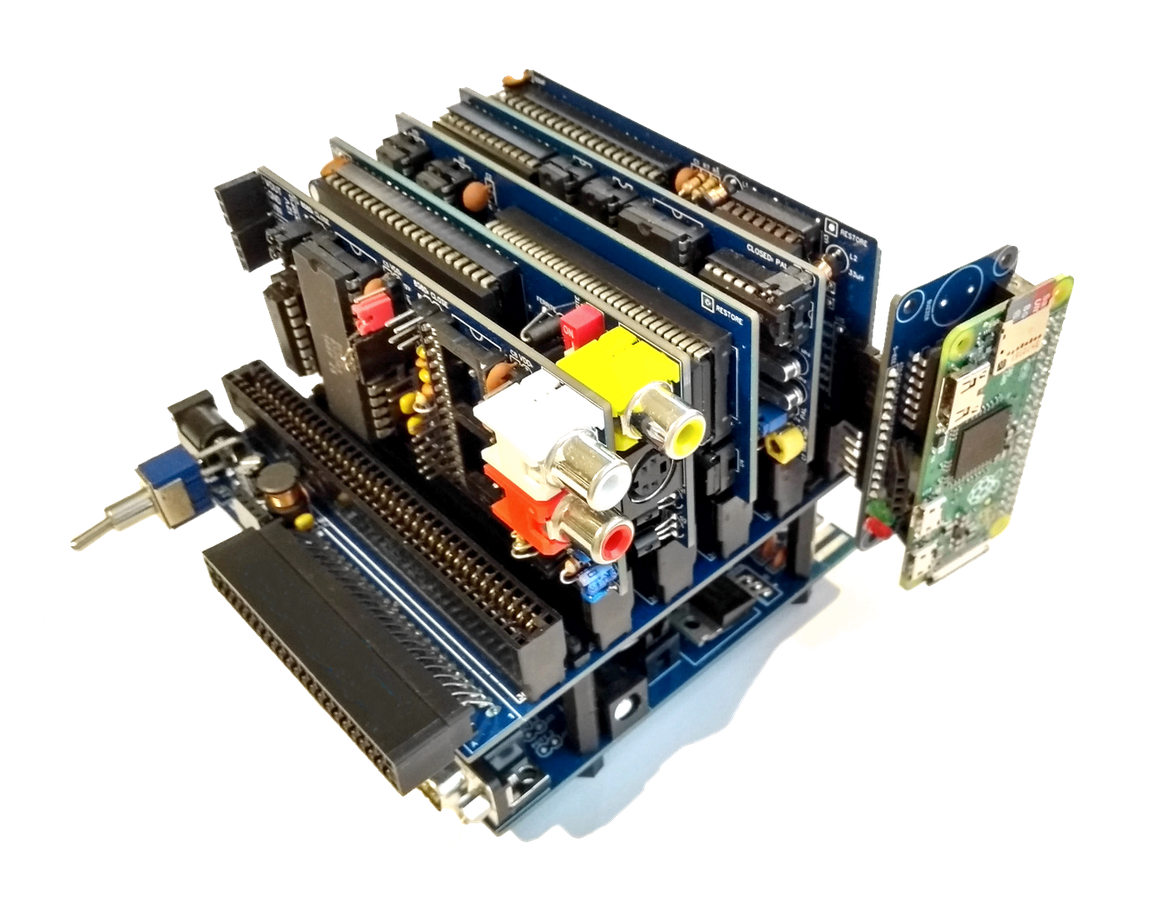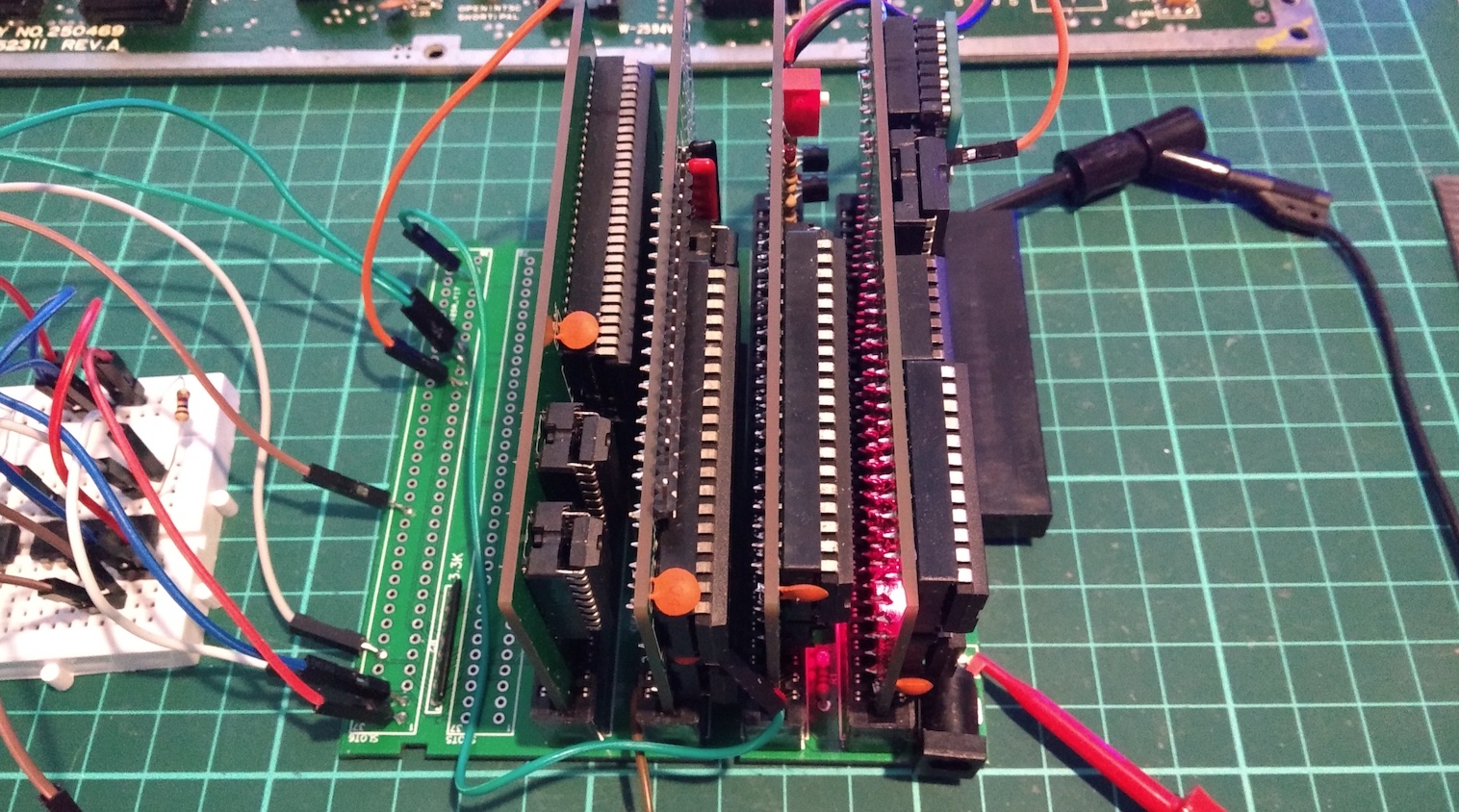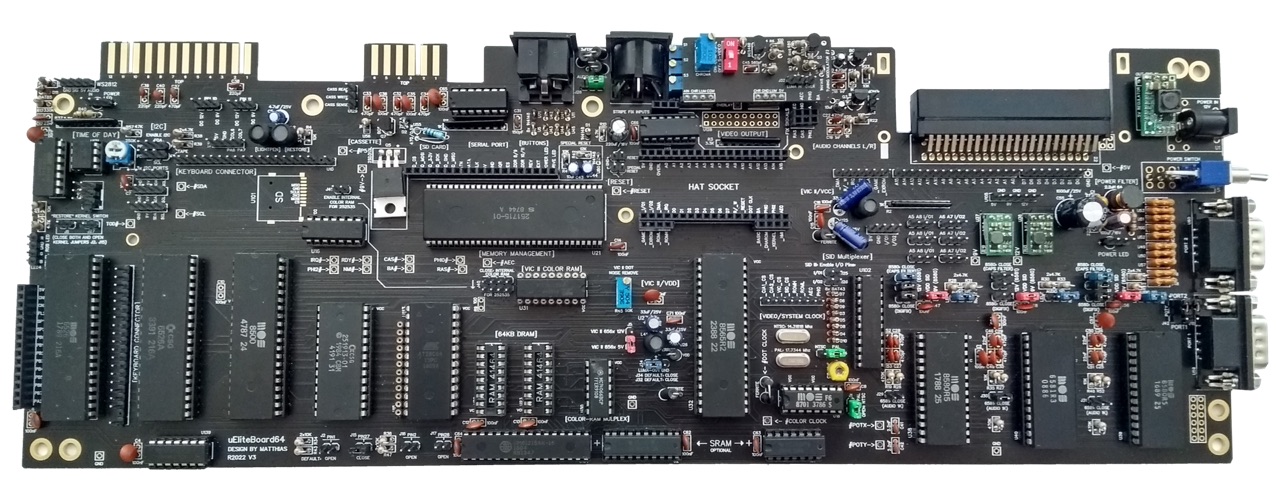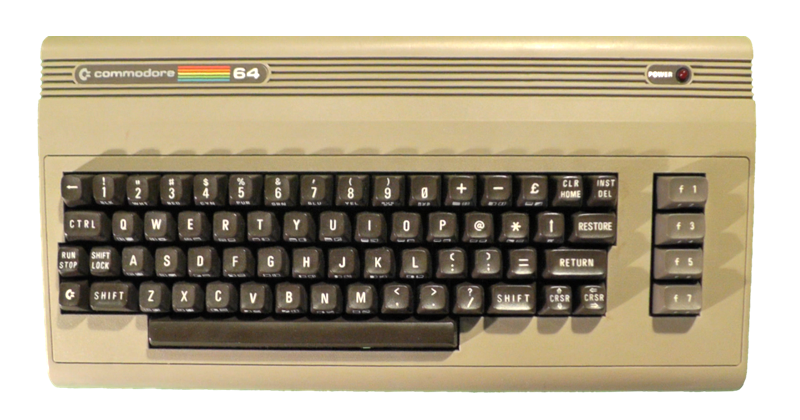|
||||||||||||||||||||||||||||||||||||||
|
Commodore 64
The Development The development of the Commodore 64 started in early 1981 with the project name "VIC-40" which was planned as the successor of the VIC-20. Since the MOS engineers Charles Winterble and Al Charpentier got no support from the marketing for a new VIC-40, these discussed their plans concerning their VIC-40 secret project in the silence in a restaurant Friday at night. This was also the birth of the 6510 processor, a 6502 with I/O functions. It was also the birth of the 6526 CIA "Charlie's Interface Adapter", which was later renamed the "Complex Interface Adapter" and finished by Bob Yannes. However, the planned sound and graphics chip caused the most discussion. Charles and Al wanted to design the world's best gaming chip. After consulting with Jack Tramiel, Charles Winterble and Al Charpentier and the team began investigating all possible computers available at the time, including the Mattel Intellivison, anything from Atari, and the TI 99/4A from Texas Instruments. Al Charpentier was particularly interested in sprites. At the end they decided to use 8 multicolored sprites, a doubling in contrast to Atari's machines, which could only display 4 monochrome sprites. In the course of this, they only got 2 hours of sleep in the 10 days Jack Tramiel gave them to analyze the computers. After these 10 days, Jack Tramiel gives his approval in April 1981 for the development and production of the new 6566 VIC-II graphics chip. During the VIC-II development, Bob Yannes is working in parallel on the new sound chip, whose passion is electronic music generation. The engineers call this new sound chip the "Sound Interface Device" 6581, or SID for short. Bob Yannes wanted something sophisticated in terms of sound and especially amplitude control, where a sound could change its volume as it progressed. In the common sound chips of that time there was only sound on (full volume) or sound off (no volume). The SID was planned with 32 voices, but due to lack of time it became the well known 3 voices with 4 waveforms each: Sawtooth, Square, Triangle and Noise. Both chips were developed in record time, requiring only 9 months development time. The usual development time was twice as long. During the development of the chips, Commodore first worked on high-end computers as well as the game console Ultimax in 1981, before the engineers talked with Jack Tramiel about a successor for the successful VIC-20. In the course of the discussion of the VIC-40 it also came to the decision of the RAM size, whereby Jack Tramiel decided for 64K byte, because the competition, including the Apple II, offered at that time maximally 48 KByte, and he was sure that the RAM prices will fall up to the sales start, whereby he proved foresight. Jack Tramiel also planned to introduce the new VIC-40 at the January 1982 Consumer Electronics Show (CES) in November 1981. Therefore, in December 1981, Charles Winterble assigned the project to Bob Yannes, Robert Russel and Dave Ziembicki, who thus had less than 2 months to build the complete computer system. In the course of the tight schedule, there is no time for a new case, and it is decided to use the case of the VIC-20 with a slightly different color. So the computer is ready in time for the January CES 1982. Naming and Presentation Until shortly after arriving at CES in January 1982, Commodore's marketing department knows nothing about the new VIC-40 computer, still focused on marketing the successful VIC-20 computer. After the engineers demonstrate the complete computer in a suite to Jack Tramiel, he gives the OK for the CES exhibition and informs marketing about it, who now frantically create promotional material for the prototype. In the course of this, and completely in the sense of the previous Commodore computers P128 with 128 KB RAM and B256 with 256 KB RAM, the marketing would like to rename the VIC-40 in C64, which then also happens (C64/C64C Service Manual). Due to the magic memory size of 64 KByte, the impressive sound chip 6581 (SID) and the 8 freely movable multicolored hardware sprites in the VIC-II chip, the visitors at the CES queue up in front of the Commodore booth, and so the C64 becomes a sensation, also because it appeared out of nowhere without any advance notice. Production Since Jack Tramiel wants to go into production with the new C64 as quickly as possible, he expects his engineers to complete the production-ready computer in only 3 months. In April 1982 it became clear that this schedule cannot be kept. In the course of the completion, the problem of the color representation is worked on, with which not only Commodore, but also Atari and Apple have to fight, since brightness and color tone overlap. Charpentier therefore made a change by separating the color timer from the refresh rate. This solved the color problem, but the timers no longer ran in phase and the image waved. For this reason, a phase controller had to be installed, which was only available from Texas Instruments, who directly competed with the C64 with their TI-99/4A home computer. Commodore managed to copy the chip and produce it themselves. The complete C64 ended up costing only $130 to produce. It goes on sale for $600, the usual quadrupling of the manufacturing cost, after the principle that the manufacturing price is doubled and given to the dealers, who in turn double the purchase price, which is then the selling price. The C64 goes into production in June 1982. In the course of the production still numerous problems arise. To get all components into the small case, they were arranged close together, which led to problems. In April 1982 Robert Russel sends ROM code unchecked to the factory, where immediately hundreds of thousands of chips are produced. Only later was a bug discovered that made some upper case letters lower case, rendering hundreds of thousands of ROM chips useless. Delivery problems of chips also caused delays. The VIC-II also has a "sparkle bug", where a hot VIC-II produces light blue dots in the background. Errors are also made during production in the manufacturing halls. The video modulators of the C64 are wrongly calibrated by the assembly line workers, which results in an oversaturation of the picture. In addition, the use of electrical screwdrivers cuts the conductive paths for the 1541's drive connector. The non-existent "KERNAL" In the course of the VIC-20 release, Robert Russel, who was involved in the development of the VIC-20 and C64, makes a mistake in using the actual word "Kernel": "I made a mistake in the heading on the first page". The consequence of this can be read in the respective "Programmers Reference Guide" of the VIC-20 and C64. Not only back in 1981, but also until today, most C64 users fall for this mistake, and misspell the word "Kernel". Even on the pages of Wikipedia, the word Kernel is misspelled on countless pages. The non-existent "IEC" Bus The serial protocol used by Commodore in its computers is the IEEE-488 Parallel Bus standardized in 1975, which Commodore later converted into a serial version. Previously, the parallel IEEE-488 Bus was used in the Commodore PET from 1977, but this bus became too costly for Commodore, leading them to develop their own cost-effective serial version of the IEEE-488 Bus. There was never an IEC Bus, but the term continues to be used on some websites. On the outside of the C64 case, this connection is labeled as "Serial" (Serial Bus), and in the C64 manual, it is also referred to as "Serial." Therefore, it is clear that the correct term is "Serial Bus." Sale Nationwide sales of the C64 begin in August 1982 and were initially sold through ComputerLand and other chains. At the beginning the C64 and the completely overstrained power supply causes apartment fires, and also the Sparkle bug continues to occur, whereby the error is discovered by Al Charpentier later in a ROM chip. Commodore additionally struggles with 1541 drive problems, as drive heads became misaligned. Despite all these problems, the C64 turns out to be a best seller. In the first two weeks Commodore sells 12,000 units, in the next 3 months until December 1982 another 65,000 units. The following Christmas business exceeds all expectations. Due to various events the interest in computers is stoked, and under these conditions the triumphal procession of the C64 begins in 1983, which is to last until 1994. Exact sales figures for the C64 do not exist, but estimates range around 25 million units sold, making the C64 the best-selling home computer of all time and a cult object of the 80s. Technical data Processor: CPU 6510, 1 Mhz Graphics: VIC-II 6567 (NTSC), 6569 (PAL) Memory: 64 KByte DRAM Sound: SID 6581 UNI64 Computer - The further development of the C64 In contrast to some C64 replica boards or emulators, which only want to preserve the C64 but not fundamentally change it, and thus do not offer new and diverse possibilities, the new developments of the UNI64 computers go new ways with the C64, which inspire and amaze many people. Especially the new forms or the special features make these new developments so interesting for open-minded computer users.  The starting signal was given in October 2019 with the development of the uAX64 Mini, which had a footprint of only 100x100mm, making it the smallest C64 in the world to date that uses the original chips of the C64. This offers the possibility to put 6 cards into 6 existing slots, which together make a C64 expandable in seconds with unimagined possibilities.
The starting signal was given in October 2019 with the development of the uAX64 Mini, which had a footprint of only 100x100mm, making it the smallest C64 in the world to date that uses the original chips of the C64. This offers the possibility to put 6 cards into 6 existing slots, which together make a C64 expandable in seconds with unimagined possibilities.
 The development of the uAX64 Mini prototype turned out to be a bit bumpy. After the first prototype was assembled, nothing worked. After 3 days and numerous error corrections, flying wires and adapters, the power-on screen of the C64 appeared for the first time, but without a blinking cursor. It took another 3-4 board versions until everything worked properly. The difficulty in the development was the limited number of pins, because in order not to exceed the 100x100mm size, only 72 pin slots could be used. 72 pins sound like a lot, but they were not enough to connect everything together. In the end, the Restore key line had to be optionally routed through a connector. On the right side of the uAX64 Mini a possibility was created to plug the Pi1541 externally to the system to connect an original 1541 in miniature format.
The development of the uAX64 Mini prototype turned out to be a bit bumpy. After the first prototype was assembled, nothing worked. After 3 days and numerous error corrections, flying wires and adapters, the power-on screen of the C64 appeared for the first time, but without a blinking cursor. It took another 3-4 board versions until everything worked properly. The difficulty in the development was the limited number of pins, because in order not to exceed the 100x100mm size, only 72 pin slots could be used. 72 pins sound like a lot, but they were not enough to connect everything together. In the end, the Restore key line had to be optionally routed through a connector. On the right side of the uAX64 Mini a possibility was created to plug the Pi1541 externally to the system to connect an original 1541 in miniature format.
 Shortly after that followed the uEliteBoard64, which seems to be impossible to implement due to the "short board" format and the amount of features, but nevertheless could be realized. Among the countless possibilities are the 3 SID sockets, I2C connectors, KERNEL ROM switch via RESTORE button, SRAM socket OnBoard, HAT socket for internal pluggable extensions, as well as many measuring points which invite not only to experimenting, but in conjunction with the many possibilities, can also be used very well for the development of new hardware and software. In addition, the video modulator with its two sockets can be easily replaced. A Stripe-Fix option is also built in. WS2812 RGB led strips can be controlled via an adapter board (optionally automatically via the SID). Shortly after that followed the uEliteBoard64, which seems to be impossible to implement due to the "short board" format and the amount of features, but nevertheless could be realized. Among the countless possibilities are the 3 SID sockets, I2C connectors, KERNEL ROM switch via RESTORE button, SRAM socket OnBoard, HAT socket for internal pluggable extensions, as well as many measuring points which invite not only to experimenting, but in conjunction with the many possibilities, can also be used very well for the development of new hardware and software. In addition, the video modulator with its two sockets can be easily replaced. A Stripe-Fix option is also built in. WS2812 RGB led strips can be controlled via an adapter board (optionally automatically via the SID).
Forum Wars In the last few years, the question came up again and again, why I'm no longer active in C64 forums. The answer is quite simple, there are now too many asocial people (who use words like: "pig", "asshole", "cock", "fuck off", "horny", ...), they are more or less bullying other people -Wage war. Unfortunately, this is not an uncommon problem in forums, but is increasingly being noticed in society in general, with people losing more and more of their level. Below is a list of what I noticed: A sadly very sad chapter is often overlooked, the disrespectful/offensive behavior in forums, or the attempt to defame and discredit people. Often, many users are unaware of this activity, which often leads to incorrect assessments of forums (what is not seen does not seem to exist). Many things are often played down and those affected are left alone with the problems. This behavior is not new, but a pattern that can be found everywhere (right-wing extremism in the army, abuse in the church, war crimes, bullying at school, threats of violence/death threats in amateur soccer, ...). Where all this can lead, if nothing is done, could be seen at the Hatespeech-Epedimie in the internet. An example of a more prominent victim recounting his experience in a YouTube video can be seen here: https://www.youtube.com/watch?v=ofg33zk9uCA&t=710s (→LINK) A commentary on this case was posted by "Christopher Gaul" under the YouTube video (2022, 3rd comment with "sort by newest date"): "I was around for the "PLA Wars" on the forums and they really did hammer Eslapion" In the video the asocial behavior of Groepaz (commonly known as Tobias Korbmacher / Hitmen, cf. > link <) is condemned, regarding a PLA Eprom newly presented by a user in the Lemon Forum, because Groepaz tried to discredit the user, as the user himself says in the video (later, after this problematic behavior, Groepaz changed his Lemon Forum name from Groepaz to Tobias). As Thomas 'skoe' Giesel, the author of "The C64 PLA Dissected" (Link), in its PLA tests of this extraordinary eprom has determined, the eprom recommended by the user works fine, and caveats to all PLAs: "However, there can never be a guarantee that a PLA or PLA replacement works on absolutely every board with any extension ever designed. The different lots and revisions of C64 computers with different VIC-II chips have different timing requirements, which was also known to Commodore: They defined different RC delays for different combinations" That speaks a clear language. Unfortunately, it is not known whether Groepaz / Tobias Korbmacher has ever apologized for his asocial behavior, and the obvious > damage < that was caused by it. Judging by the reaction of the user in the video, this probably did not happen. But this is not the only questionable behavior of Groepaz / Tobias Korbmacher. If you continue to research on the Internet, more and more strange things come to light, as you can see here: > Link < and here > Link < . This harmful as well as more than questionable behavior of Tobias Korbmacher / Groepaz is underpinned by an impressive confession: "I have to admit that Groepaz (note: alias Tobias Korbmacher) ends a conversation pretty quickly when it becomes technically invalid. He does this in a quick, harsh, and sometimes "socially unusual" way. ... This is just a side of his personality that you have to learn to live with. It's the reason why he's in *development* and not in customer support." (Wiesel). All of this speaks volumes, of course. One must state that a lot is "assumed" and "believed", as well publicly "asserted", and this apparently not seldom wrongly (> link <). And as if that alone wasn't enough, there are also "accomplices" in the C64 scene who apparently collectively and purposefully try to discredit individuals, sometimes subtly, sometimes not so subtly. It is striking that these noisemakers not infrequently come from Germany / Netherlands. But what is even more astonishing is that supposed "experts" not only have considerable gaps in their knowledge, but on top of it all behave asocially. But this is only the tip of the iceberg. The user in the YouTube video above later turned to another forum. Gradually, I came to understand the absurd wars waged in forums and the partially uncouth, asocial, and ruthless individuals who sometimes wreak havoc there, which was relatively new to me in this dimension. I myself was once contacted in a forum, where I was warned about a user, but it later turned out that this warning was a form of bullying (defamation), directed towards a completely harmless and friendly user, and the accusations proved to be baseless. In another instance, I had to witness three C64 forum moderators simultaneously putting themselves in verbal distress with an user for absolutely no reason whatsoever. The user later remarked, "I felt backed into a corner." Such asocial behavior with similar kind of cases there were in the past years apparently dozens, over the decades possibly even hundreds, judging by what I have witnessed in 2 years, and from conversations with victims, as well as what I have been told by older forum members who have been around for decades. Quite a few have given up their C64 hobby because of such incidents. I can't stand by and watch something like this happen and of course you have to express your displeasure about this and other asocial behavior of the moderators and also users out of a sense of duty in the form of civil courage. However, what usually follows is no understanding and no excuse for this asocial behavior, but attacks, personal attacks. In my case this meant that my projects suddenly became a target, just like the users who presented my fascinating projects.. As mentioned, just the tip of the iceberg. At some point, after careful consideration, I decided to leave forums, because I did not want to support these wars that are being waged against people with my presence. Because that is something that the world does not need. I then established my own forum, with a special emphasis on respect, where users can seek protection from these constant attacks, and naturally, this new forum and I as an individual were also undermined endless, in best stalker style. This impressively highlights the scope of the problem. However, I did not want to permanently involve myself in this war, as there are so many wonderful things one can do in life, so I did not wish to squander my time on it. However, it is important to address these things and counter the possible lies that are being spread. In retrospect, I understand the statements of C64 fans who vehemently resisted joining a C64 forum. With very good reason. It is very unfortunate that some people can not help but constantly attack other people, and shoot far beyond the reasonable target, and lose any human sense of proportion. Probably they have to meet an even bigger bully first, so that they realize on their own body what they do to other people. |
||||||||||||||||||||||||||||||||||||||

